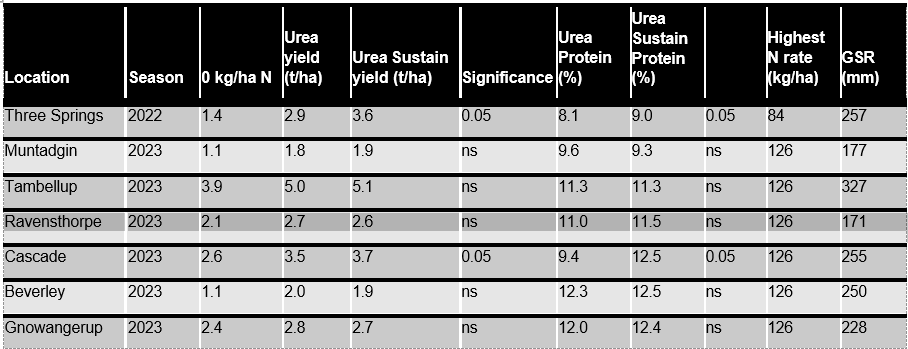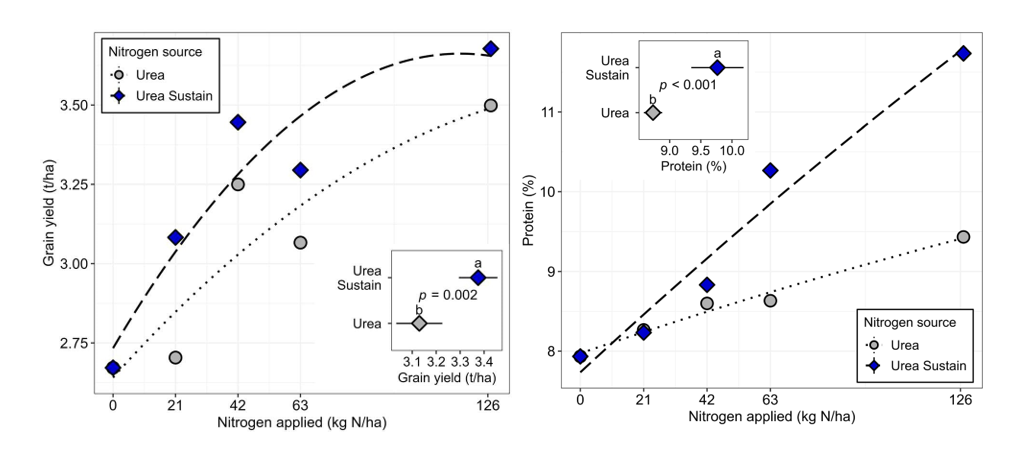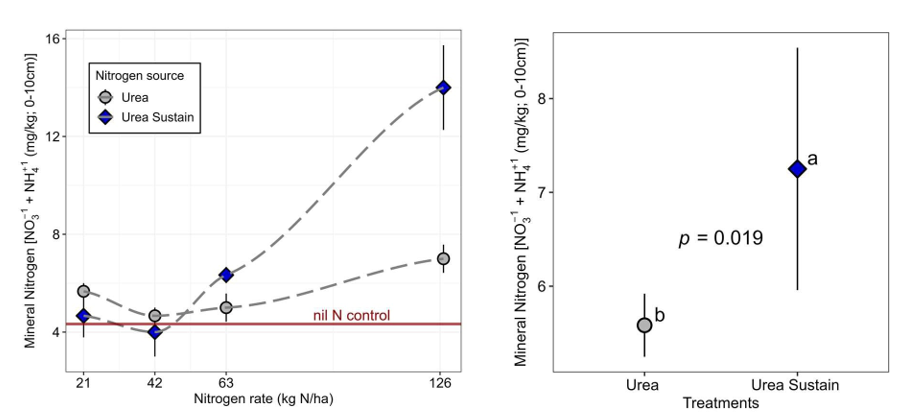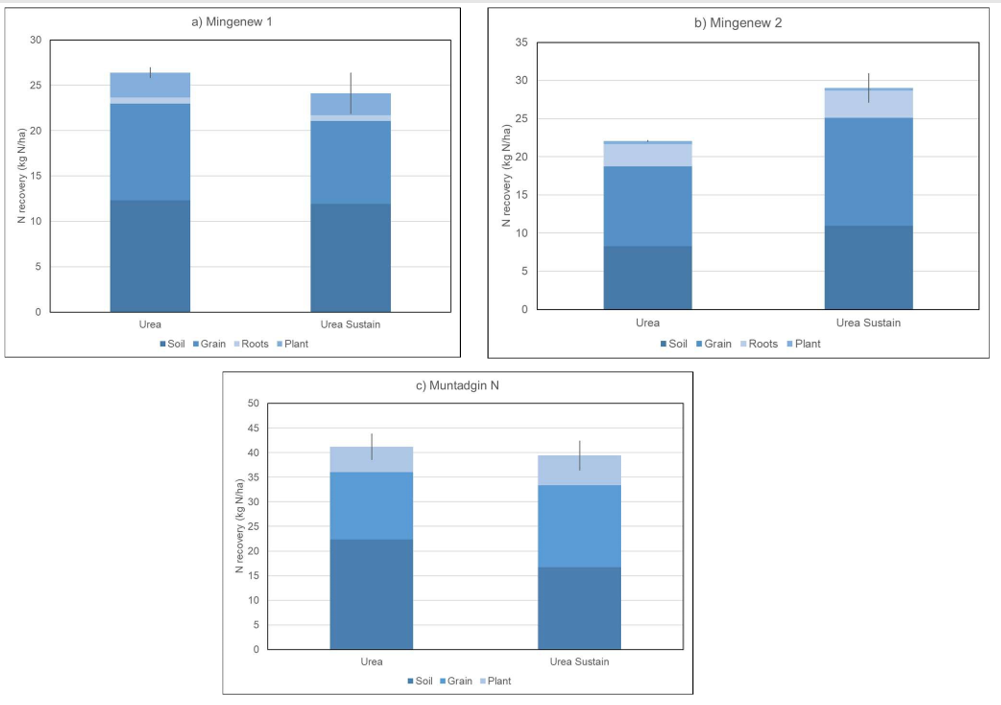Can urease and nitrification inhibitors improve nitrogen use efficiency in WA cropping?
Can urease and nitrification inhibitors improve nitrogen use efficiency in WA cropping?
Author: Peter Rees, Gustavo Boitt, Andreas Neuhaus and James Easton | Date: 26 Feb 2024
Key messages
- CSBP field trials have been evaluating Urea Sustain (urea coated with urease and nitrification inhibitors) to boost nitrogen use efficiency and grower returns.
- The results show inhibitors can be effective in improving yield, nitrogen use efficiency and grower returns.
- Across seven replicated field trials in 2022 and 2023, Urea Sustain boosted wheat yields by an average of 5.6% and increased protein by 0.3% over urea. In conditions conducive to nitrogen losses, wheat yield increases were as high as 700kg/ha (25% higher than urea).
Aims
To compare the nitrogen losses between urea and Urea Sustain (urea coated with NBPT and DMPP inhibitors) in WA cropping systems by investigating yield, plant nitrogen uptake and residual soil nitrogen.
Introduction
Nitrogen losses from ammonia (NH3) volatilisation, denitrification and leaching have become an area of concern as growers look to decrease environmental impacts and improve profitability. Increasing nitrogen use efficiency (NUE) helps growers maximise yield and economic return, while decreasing nitrogen (N) losses.
Nitrogen fertiliser losses from volatilisation have been reported at up to 30% of applied N in field trials in WA1. Losses are dependent on fertiliser type, environmental conditions (temperature, rainfall, wind speed) and soil properties (clay content, CEC and pH)2. Losses can be high two to six days after application if there is insufficient rainfall to wash the urea into the soil profile.
Leaching losses occur when N, most often as nitrate (NO3-) dissolved in water moves through the soil profile, draining below the root zone. Rates of loss are highly dependent on soil type, N application rate and rainfall, but N leaching losses on sands have been measured at up to 72kg/ha and modelled as being higher3.
Any applied fertiliser not converted to grain represents an economic loss as well as a potential environmental impact. With current NUE for N applications estimated at 30–60% it makes sense to investigate technologies and products that help crops take up more fertiliser N.
The inhibitors assessed as part of this study are a urease inhibitor (NBPT) and a nitrification inhibitor (DMPP), which are aimed at reducing volatilisation and leaching.
NBPT slows down the conversion of urea to NH3 and increases the proportion of N available for the crop. International literature suggests that NBPT can boost wheat yields by an average of 10% where NH3 volatilisation is an issue4.
DMPP aims to slow down the conversion of ammonium (NH4+) to NO3- by soil bacteria. By keeping N in the positively charged NH4+ form rather than the negatively charged NO3- form, the N applied should be less susceptible to leaching.
CSBP has introduced a new product, Urea Sustain, which is urea coated with both NBPT and DMPP. This is designed to decrease the potential for volatilisation and leaching and increase NUE. This paper summarises the findings of wheat field trials from the 2022 and 2023 seasons and outlines a field study using 15N recovery to investigate the benefits of the inhibitors in WA cropping systems.
Method
Field trials
In 2022 and 2023 seven replicated small-plot field trials were conducted across the wheatbelt comparing urea to Urea Sustain top-dressed post seeding in wheat at different rates of N. Locations and key soil and seasonal information for each trial are presented below (Table 1).
Rates of applied N ranged from 0kg/ha up to 126kg/ha in all 2023 trials, but only to 84kg/ha in Three Springs in 2022.
Table 1. Locations, soil and seasonal details for field trials used in this study
Additional details regarding wheat varieties, sowing dates, previous rotations and top-dressing timings are available at www.csbpresults.com.au.
Trials were fully randomised and maintained in line with farmer standards throughout the season. They were assessed for N uptake by tissue testing during the season and assessed for yield using a small plot header with grain samples taken for grain quality and nutrient status.
All soil and plant samples were analysed by the CSBP Laboratory in accordance with methodologies detailed on their website www.csbplab.com.au.
After the season, carbon intensity (a measure of kg CO2 equivalent per tonne of grain) was estimated for all trials using the University of Melbourne G-GAF calculator5.
15N microplot study
In addition to these field trials there were also three unconfined microplot comparisons using 15N-enriched urea and 15N-enriched Urea Sustain. Two were conducted at Mingenew (16 June and 20 July topdressing) on grey sand and one at the Muntadgin field trial. Replicated plots of 1.5m x 1.5m were pegged within the farmer-sown crop and spread with 15N urea or 15N Urea Sustain at the equivalent of 42kg N/ha in Mingenew and 63kg N/ha in Muntadgin (27 June). Nil N plots were also included at each site.
At maturity, a quadrat of each plot (11% of the area) was plant sampled to allow analysis of plant material and grain for total N and 15N uptake. Soil cores were taken from within each plot down to 30cm to assess residual soil 15N supplies. At the Mingenew sites plant roots were also removed from the area within the quadrats and assessed for 15N content.
15N recovery in soil, plant and grain material was measured by Environmental Analysis Laboratory at Southern Cross University.
Results
Field trials
All sites except Gnowangerup showed a significant response to applied N and N application boosted protein in all trials. Table 1 shows the yield achieved with nil N and the yield and protein at the highest rate of N applied for each source (urea or Urea Sustain). Full trial details for each site can be found at www.csbpresults.com.au.
Table 2. Summary results from seven wheat trials in the 2022 and 2023 seasons showing mean grain yields from nil N controls and the highest N rate treatments of urea and Urea Sustain and protein content from these treatments. Significance relates to the comparison of the highest N-rate treatments.
When all trials and N rates were aggregated and analysed Urea Sustain was found to boost yields by an average of 5.6% over urea at the same rate (Figure 1). This higher yield was accompanied by slightly higher protein (average of 0.3% higher for Urea Sustain, results not shown).
The increase in yield also meant a 4.4% lower estimated carbon intensity for wheat grown with Urea Sustain relative to urea in these trials.
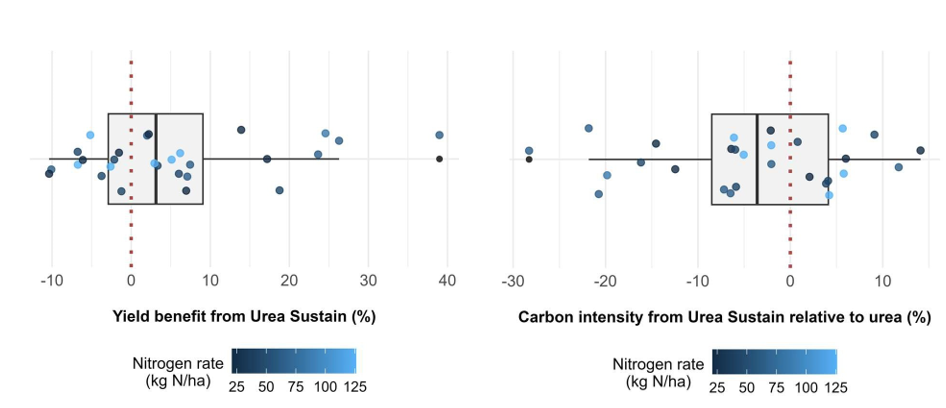
Figure 1. Relative yield benefits (LHS) and reduction of estimated carbon intensity (RHS) from Urea Sustain compared to urea when top dressed at Z11–13. Coloured dots are means of three field replicates comparing equal N rates. Boxplots show the interquartile range and medians (vertical lines).
As soil and meteorological conditions can play a large part in the performance of inhibitors it is not surprising that there is a wide range of performance results.
Where conditions were most conducive to N losses (Three Springs, 2022 and Cascades, 2023) we saw the largest increases in N uptake, yield and protein and these trial results are presented in more detail below.
Three Springs 2022
In 2022 the Three Springs trial showed a 700kg/ha yield and 0.95% protein response at the highest N rate of 84kg/ha (Figure 2).
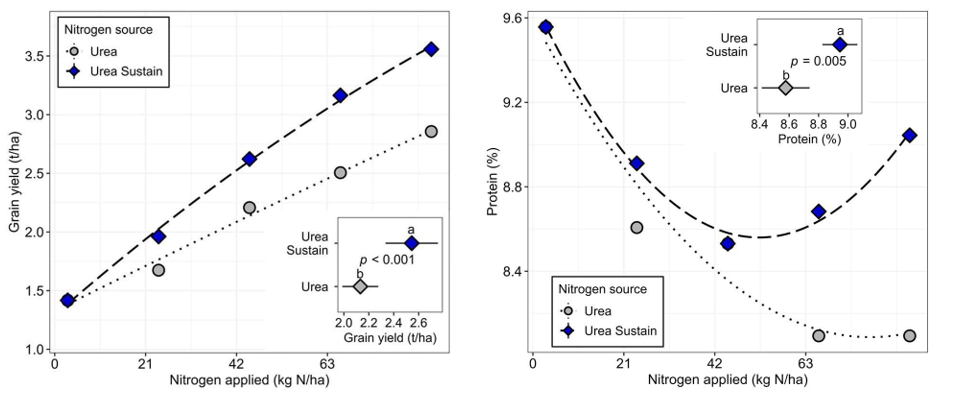
Figure 2. Wheat yield (t/ha) and grain protein (%) responses to N rates supplied as Urea Sustain or urea top-dressed at Z11–13 at Three Springs in 2022. Each dot represents the mean of three replicates.
Cascade 2023
In Cascade in 2023 we saw an 800kg/ha yield response, and a 2.3% increase in protein at the highest N rate of 126kg/ha. In addition to this, soil testing after harvest showed significantly more residual mineral N in the 0-10cm layer in plots that received Urea Sustain, with NO3- N and NH4+ N found to be an average of 30% higher than in urea plots. The difference tended to increase with N rate, with the highest rate plots showing a 100% increase in residual mineral N with Urea Sustain (Figure 4).
Figure 3. Wheat yield (t/ha) and grain protein (%) responses to N rates supplied as Urea Sustain or urea top-dressed at Z11–13 in Cascade in 2023. Each dot represents the mean of three replicates.
Figure 4. Soil mineral N (mg/kg) (sum of NO3- N and NH4+ N in 0–10cm) at Cascade with increasing rates of applied N as urea and Urea Sustain in soil samples taken after harvest (LHS) and a comparison of the N sources across all rates of applied N for residual mineral N (RHS).
15N Microplot Study
Figure 5. Nitrogen recovery (kg N/ha) in soil, plant, roots and grain material at two timings at Mingenew and in soil, plant and grain at Muntadgin as measured at maturity.
Results from the 15N trials showed no significant difference in N recovery between the urea and Urea Sustain treatments at Mingenew for the first N application or Muntadgin. At both sites rainfall data suggests there was enough rainfall to prevent volatilisation losses shortly after topdressing.
For the later application of 15N at Mingenew, where no follow up rain was received for six days after application there was a significant increase in 15N recovery in the Urea Sustain plots compared to urea, with most of the difference being found in higher grain N recovery (10 vs 15kg N/ha) and soil recovery (8 vs 11kg N/ha).
Conclusion
The results from these field studies indicate that urea treated with a urease and nitrification inhibitor can increase NUE in Western Australian cropping. Urea Sustain was shown to boost yields by an average of 5.6% over urea, which represented an increase in wheat yield of 124kg/ha across all rates and sites assessed. The value of this at harvest in the 2023 season was estimated to be $45/ha, while the average cost of coating with inhibitors across all rates of N was only $8/ha (Kwinana harvest average ASW1 $399/t less $40/t in assumed freight and charges).
Under conditions conducive to N losses (mostly by volatilisation in the seasons and locations assessed), the difference in return was much higher (up to $175/ha increase in return in the Cascade 2023 trial and $235/ha in Three Springs in 2022).
Where there is adequate rainfall shortly after application, without causing leaching, results suggest no benefit to the use of Urea Sustain over urea.
Our results show that the use of inhibitors presents an opportunity to boost grower returns and to improve NUE. The yield improvement was lower than the 10% average reported in international reviews of NBPT efficiency4, although six out of our seven trials were conducted in 2023, which was a drier season in WA and sites were less N responsive than average.
With rainfall becoming less predictable and farming operations generally growing in scale, inhibitors may also offer logistical advantages, allowing growers more certainty when topdressing crops ahead of forecast rains.
CSBP intends to continue research in this field. This includes comparing inhibitor products and rates, and alternative uses and timings to help drive improved returns and better environmental outcomes for growers across Western Australia.
Acknowledgments
The authors would like to acknowledge the CSBP Field Research team and Debra Turner, Senior Sustainable Agriculture Advisor, CSBP for their hard work supporting this research, our collaborating growers who are generous with their land and assistance and Luke Marquis and the team at SEAR for their assistance on the Cascade trial.
References
1Fillery, I., and Khimashia, N. (2016). Soil Research, 54, 1-10. Doi: 10.1071/SR14073
2Sommer, S.G. & Schjoerring, Jan & Denmead, O. (2004). Advances in Agronomy, 82. 557-622. 10.1016/S0065-2113(03)82008-4.
3Barton, L., Scanlan, C. and Hoyle F. (2016). Where does the Nitrogen go? Soil Sources and sinks in Western Australia cropping soils, GRDC Update Paper.
4Cantarella, H., et.al. (2018). Journal of Advanced Research, 13, 19-27. Doi: 10.1016/j.jare.2018.05.008


